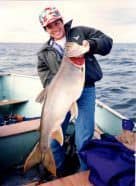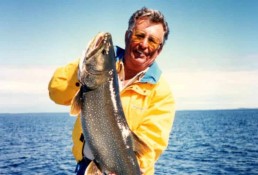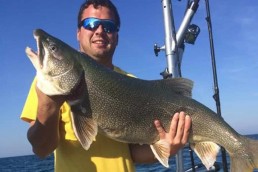Trigger Trophy Lake Trout with the Head Trick
SHARE THIS POST
“Dan, when you’re on one of those far northern trips for big fish, what do you do to produce a bite from a trophy lake trout?—You always seem to come back with a photo of a big one for MidWest Outdoors!”
This came from a young angler at the Chicago O’Hare Sports Show this January.
My answer to him was that he should order a subscription to MidWest Outdoors magazine. I told him in one of this year’s issues I’d reveal one of my secrets called the “head trick.” He looked at me in a strange way, and then headed for the MidWest Outdoors booth in the next aisle.
So, here it is.
Nineteen years ago, while on a trip to Kasba Lake in northern Canada, “Bobber” Anne and I were being guided by a cheery Irish man, Tim O’Shaunessey. Our target was the trophy lake trout Kasba is noted for. On our graph, the large trout were holding just off the bottom in 100 feet or more. We’d tried trolling large flatfish behind a 10-ounce Bait Walker, which was normally a sure thing. No luck. We’d tried vertically jigging 2- and 3-ounce Ugly Bugs tipped with a belly strip cut from a whitefish. Once again, no takers—both had been productive on previous trips to Kasba.

“Tim, I can’t believe the jig and strip doesn’t do it,” I said. “I believe that last drop nearly hit that big laker on its head. According to the graph screen there was no way she didn’t see it,” I commented, as Anne reeled in her bait.
“Guys, after lunch I’ll show you a trick with the head of that 6-pound laker we kept for shore lunch,” our guide responded.
With the lunch of fried trout fillets and corn and hash brown potatoes consumed, the three of us headed back out to one of Kasba’s deep water holes where Anne and I would receive a lesson.
“Dan, I’ll need three steel leaders, two number 2/0 or 3/0 trebles and as big of a single hook you might have in your box,” Tim requested, as we neared the spot where our graph registered a dozen large trout holding just off bottom at 110 feet.
“I kept the trout’s head and I’m about to show you how to rig it for the lakers,” announced our guide, as we slowed to a spot right over the pack of trout.
First, Tim ran the large 5/0 single hook up through the nose of the lake trout’s head, starting through the lower jaw, then out through the nose of the upper jaw. To the eye of the 5/0 hook, he snapped one of the steel leaders. Before closing the snap, the other leaders’ swivels were inserted in the snap. This was then locked short to leave the two leaders dangling down along the sides of the head.
When Tim had cut the head off he’d cut behind the two front fins and left some of the entrails hanging out (see my diagram). Next, the treble hooks were snapped onto the dangling leaders.
Are you enjoying this post?
You can be among the first to get the latest info on where to go, what to use and how to use it!
“Dan, this is the most critical part of rigging the head,” came Tim’s statement, as he twisted the right-side treble under the head and implanted one of the treble barbs into the flesh just above the left-side fin. Next, the treble on the left side was stretched down along the same left side to see one of its barbs implanted just under and below the fin on the right side.
“Rigged this way, Dan, if you troll the head behind a 10-ounce Bait Walker you get a slow-rolling action as the head bounces along just off the bottom. If you vertically jig it, the same rolls are implemented as you lift it off and lower it toward the bottom. This gives your head bait a somewhat lifelike action,” Tim explained.
From my early years of guiding on giant Lake Superior, I know that lake trout are cannibalistic in nature—all this made sense.
“Tim, that whole thing looks a bit gory,” Anne commented, as Tim tied his secret weapon to her casting rod.
Where it came from, I have no clue. But from within the cooler, our guide pulled another head. This one seemed older by its whitened color. My curiosity was answered as Tim began to rig this one in a similar fashion. The remains of yesterday’s shore lunch were now being rigged Tim’s secret way. This one would have a 3-ounce bell sinker attached to its bottom treble by a foot of 100-pound line.
With fish below us, Anne and I were instructed to drop. And with our outboard motor throttled down to a very slow troll; we began a move to encircle the pot of big fish.
The rest of this story is easy.
We each hooked and landed trophy-size lake trout on that first drop. Anne’s registered 32 pounds, mine slightly more. Both were released, and we continued to use the head trick that day and boated seven more lakers over 20 pounds, with the largest slightly over 40.
Now, I’ve given away one of my secrets that produces large lake trout; I’ve finally answered the question that the young man had at the O’Hare show.
Yes, I will revert to the head trick, and have several times since that outing with Tim O’Shaunessey, but only after looking over the fishing regulations for the lake I’m fishing on. In many states and provinces, the use of gamefish parts is strictly restricted. In some, it’s okay.
Oh, one other tip: If you’re in the far north area of grayling country and it’s a large pike or lake trout you’re after, try using the belly strip of a grayling fish on a heavy Ugly Bug. Both species just love grayling, and any part of one.
MWO
SHARE THIS POST
Did you enjoy this post?
You can be among the first to get the latest info on where to go, what to use and how to use it!
Dan Gapen
Considered one of the world’s leading river anglers, Dan Gapen, Sr. has shared his knowledge with MidWest Outdoors readers and viewers for more than 40 years. He is a member of all three Fishing Halls of Fame—International, National Freshwater, and Minnesota. He has an immense grasp of the world’s fisheries. He may be contacted at 877-623-2099.
@TheGapenCompany.




